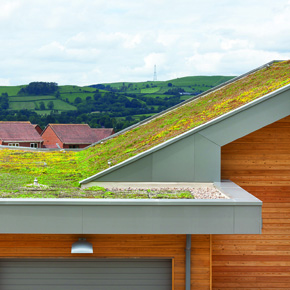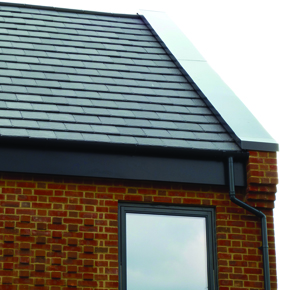
Five things to look out for when specifying aluminium coping
Coping systems are an intrinsic part of wall and edge protection and often provide specifiers with an opportunity to apply a final aesthetic frame to a building.
Choosing the right system is an important decision and here, Kevin Wallis, category manager – eaves solutions at Marley Alutec explains how architects and specifiers can get the balance right between aesthetics and durability…
From a material perspective, it goes without saying that aluminium can offer the durability and decorative attributes suitable for coping systems, however, merely citing aluminium on a specification may not ensure the service life intended.
Here are five key factors to consider that will help architects and specifiers make a fully informed decision:
Weathertight system
 The most important attribute of a coping system is its ability to remain weathertight. You could argue that a coping system that is not weathertight throughout its full life expectancy may not be fit for purpose, so it has to be the first line of inquisition. The integrity of a system will largely come down to the type of seal used at the joints.
The most important attribute of a coping system is its ability to remain weathertight. You could argue that a coping system that is not weathertight throughout its full life expectancy may not be fit for purpose, so it has to be the first line of inquisition. The integrity of a system will largely come down to the type of seal used at the joints.
Some coping systems use a rubber EPDM seal to make them weathertight. EPDM rubber seals rely on compression to maintain a weathertight seal; once the EPDM rubber’s compressible memory is lost, the system may no longer be weathertight, resulting in water ingress.
The best type of seal is a butyl adhesive seal, which will long outlast the EPDM alternative. The combination of compression and adhesion means that the system will remain 100% weathertight throughout its life.
Wind resistance
Wind rating is another important consideration, particularly for installations at height. Nothing could be worse than having a coping system come loose and being blown away in the wind, posing significant risk to public health and damage to property. To be safe, specify a system that has been tested by a certified test centre to withstand winds above the highest speeds recorded in that area – which in the UK is 173mph.
Ease of installation
It is worth considering ease of installation; this will directly affect the overall cost of a project and how closely the finished installation meets the original design intent. Composite aluminium is a good choice as it is extremely lightweight and rigid, meaning it is easier and safer to handle on site – particularly when working at height. What’s more, some of these systems can be easily modified on site using standard carpentry tools.
Durability
The next thing to consider is durability. Coping by default is almost always located in an awkward to access position. It is therefore important that it stands the test of time well, so that it doesn’t have to be replaced frequently and maintenance requirements are kept to a minimum. Therefore, look for long life expectancies – the best last for 50 years or more. It is also worth looking for manufacturers that offer colour-stable, architectural grade paint finishes and even Nano self-cleaning technology to keep maintenance costs to a minimum.
Aesthetics
Finally, aesthetics must come in to play. For most projects, coping systems should provide a clean, crisp edge to frame the building.
 Aluminium provides a smooth finish, however, some sheet aluminium systems can suffer from bowing (particularly on walls with a wide girth). Rigidity is therefore important to achieve a consistent uniform finish; ask manufacturers about maximum widths and get hands- on with the product if possible to test its flex.
Aluminium provides a smooth finish, however, some sheet aluminium systems can suffer from bowing (particularly on walls with a wide girth). Rigidity is therefore important to achieve a consistent uniform finish; ask manufacturers about maximum widths and get hands- on with the product if possible to test its flex.
Coping plays a crucial role in building envelope protection but unfortunately doesn’t always place highly on the design agenda.
Find out more in the May issue of ABC+D Magazine
Latest news

29th April 2025
Senior pledges to ‘bee’ part of the solution with new biodiversity initiative
Senior Architectural Systems has installed its first on-site beehive, marking another step forward in its commitment to sustainability and biodiversity.
Posted in Articles, Building Industry News, Building Products & Structures, Building Services, Curtain Walling, Doors, Glass, Glazing, Innovations & New Products, news, Restoration & Refurbishment, Retrofit & Renovation, Sustainability & Energy Efficiency, Walls, Windows
29th April 2025
West Fraser range delivering key benefits for South-East carpentry company
An experienced carpenter and building site manager who has recently set up his own company is using high performance panel products from the West Fraser range.
Posted in Articles, Building Industry News, Building Products & Structures, Building Systems, Case Studies, Garden, Restoration & Refurbishment, Retrofit & Renovation, Sustainability & Energy Efficiency, Timber Buildings and Timber Products
29th April 2025
CPD Courses Available Online From Ecological Building Systems
Ecological Building Systems, a leading supplier of natural building products for sustainable construction, has revealed its comprehensive CPD programme for the year ahead.
Posted in Articles, Building Industry Events, Building Industry News, Building Products & Structures, Building Services, Continuing Professional Development (CPD's), Information Technology, Innovations & New Products, Insulation, Restoration & Refurbishment, Retrofit & Renovation, Seminars, Sustainability & Energy Efficiency, Training, Walls, Waste Management & Recycling
29th April 2025
WindowBASE launches new prospect databases at FIT Show
Visit WindowBASE at the FIT Show to see first-hand how it helps companies find new customers – the company is launching an easy-to-use, intuitive platform on Stand G16 at the NEC Birmingham from 29th April – 1st May.
Posted in Articles, Building Industry Events, Building Industry News, Building Products & Structures, Building Services, Doors, Exhibitions and Conferences, Glass, Glazing, Information Technology, Innovations & New Products, Posts, Publications, Research & Materials Testing, Restoration & Refurbishment, Retrofit & Renovation, Windows
 Sign up:
Sign up: